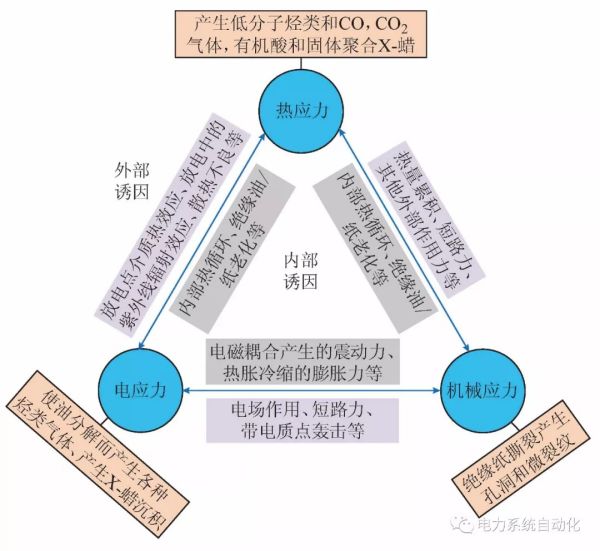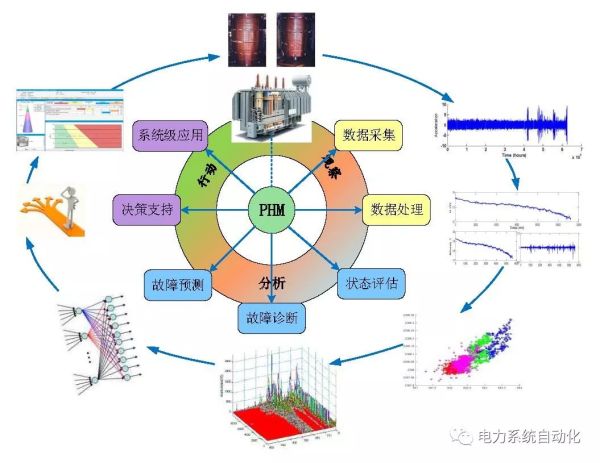
Privacy statement: Your privacy is very important to Us. Our company promises not to disclose your personal information to any external company with out your explicit permission.
![]() July 29, 2022
July 29, 2022
First, the research background
As the safety critical equipment of the power system, the Power Transformer is also one of the most expensive and complicated equipment. At present, the number of transformers of 110kV (66kV) and above in the State Grid Corporation has reached more than 30,000, with a total capacity of 3.4TVA. Because the power transformer is at the center of the power grid, the operating environment is complex and often suffers from various adverse operating conditions. Once a fault occurs, it is very likely to cause a sudden large-scale power outage, or even an accident such as an explosion or fire. Direct and indirect economic losses amounted to several hundred million yuan. Therefore, it is of great theoretical significance and practical value to overcome the key technologies such as health management and fault warning of power transformer operation status to improve its ability to prevent and respond to faults and ensure safe and stable operation of power grids.
At present, most of the research methods commonly used in power transformers are based on a certain factor or a few factors. The comprehensive state information of the transformer is not comprehensively considered, and the limitations of the test methods and the inaccuracy of knowledge are caused. The information has characteristics such as ambiguity and randomness, and the accuracy and timeliness of the diagnosis results are far from practical requirements.
Prognostic and Health Management (PHM) is a theory and technical system that uses advanced sensor technology and uses various algorithms and intelligent models to monitor, predict and manage the health of the system. Solve the problems of “under-maintenance” or “over-maintenance” caused by post-fault repair and regular maintenance, and then gradually replaced by state maintenance or predictive maintenance. PHM has developed rapidly in the fields of aviation, electronics and machinery. However, the PHM method for power transformers is still not perfect, mainly reflected in: 1 The health monitoring of transformers mostly focuses on chemical and electrical faults, and rarely pays attention to mechanical faults; 2 the oil, gas and temperature of transformers are widely used for health monitoring. Compared with diagnosis, vibration signals are rarely used; 3 research on transformer PHM is currently only in the monitoring and diagnosis stage, and research on fault prediction and residual life (RUL) prediction is still rare.
Second, the complexity analysis of power transformer faults
From the historical statistical records of the current power system operation, the external faults of the power transformer, the insulation moisture, and the poor contact of the tap changer contacts occur most frequently. The order of frequent faults is roughly the winding, the iron core, the tap changer, Casing, insulating oil, cooling system, protection device, test system, fuel tank. In addition, the power transformer will be subjected to a combination of internal and external stresses such as “electro-magnetic-force-heat” during operation, thereby destroying the insulation performance of the transformer, resulting in defects or even failures, as shown in Fig. 1.

Figure 1 Main factors affecting the normal operation of power transformers
Therefore, the single use of traditional physical modeling methods has become inadequate for large power transformers. Through the comprehensive application of modern electrical science, information science, data science and mature system science methods, it is expected to provide practical solutions and solutions for the analysis and management of power transformer health.
Third, the power transformer PHM connotation and trend analysis
The PHM method is currently mainly divided into data-driven methods, model-driven methods, and hybrid methods. Further, the data-driven method has two kinds of statistics and machine learning; the model-driven method has a failure physical analysis and a system model method. At present, the data format and scale for power transformer condition monitoring have increased significantly. For example, real-time operational data, condition data, defect information, maintenance history, family quality history, and other information coexist. Thanks to advanced information technology and big data processing methods, it is feasible and feasible to carry out data-driven PHM processes in the field of power transformer management and maintenance.
In general, PHM covers data acquisition, data processing, state assessment, fault diagnosis, fault prediction, decision support, and system-level application. It can realize the correlation from fault mechanism to remaining life, which is related to the health management cycle of power transformers. Basically consistent. Figure 2 initially defines the PHM cycle of the power transformer.

Figure 2 Power transformer PHM cycle
3.1 Health monitoring
At present, most researches on power transformer evaluation, diagnosis and prediction are based on DGA data, but the theoretical research results based on DGA data still have certain limitations in practical applications. The vibration signal analysis method has no electrical connection with the entire power system, has no influence on the normal operation of the power system, and has strong anti-interference ability and sensitivity. Therefore, in recent years, the transformer PHM method based on vibration data has received extensive attention. The relevant state information inside the transformer is reflected by the real-time vibration data. In addition, the health monitoring of power transformers from the perspective of image recognition also has certain reference significance.
3.2 Feature Extraction and Fault Diagnosis
Health Index (HI) plays an important role in characterizing the health status and degradation degree of transformers. The key to constructing HI lies in the extraction, selection and fusion of related features. At present, the improved three-ratio method recommended by the industry standard DL/T722-2000-"Guidelines for Analysis and Judgment of Dissolved Gases in Transformer Oil" exposes defects such as lack of coding and excessive coding boundaries in practical applications. Therefore, some intelligent diagnostic algorithms have been proposed. For example, fuzzy theory, support vector machines, rough sets, grey theory, deep learning, etc. To this end, the future transformer fault diagnosis will be based on complete data-based, multi-algorithm fusion deep diagnosis.
3.3 Failure prediction
In current domestic and international literature, research related to prediction is highly dependent on research related to diagnosis. This is because the diagnosis involves identifying and quantifying the fault that has occurred (essentially retrospective), while the prediction is to predict as much as possible the fault that has not occurred, and the prediction must depend on the output of the diagnosis (eg fault indicator, degradation rate, etc.), both Can not be done in isolation. Accurately making residual life prediction is the core and foundation of PHM, and it is also the key and prerequisite for correct decision-making. However, the existing life predictions are based on the aging formula of the electrical equipment health status of EATechnology in the UK:

Where DHI is the health index and B is the aging factor.
Although the theory can calculate the approximate value of the remaining life, the value is too absolute. Therefore, how to construct the probability density distribution function of the remaining life of the power transformer and obtain the probability distribution interval is also a difficult problem in the future.
Fourth, issues to be further studied
At present, the PHM research of power transformers is still at a preliminary stage, especially in the field of maintenance and operation management of large-scale power transformers. The author believes that there are still some problems that need attention:
4.1 Power Transformer Big Data
With the large deployment of advanced sensing devices on the surface and inside of transformers, transformer detection technology tends to be intelligent. The data presents multiple and heterogeneous big data features. Figure 3 shows the multidimensional characteristics of power transformer big data in the form of data cubes. The big data storage management, parallel processing and mining technology for power transformers will be the direction for future research on refined management of transformers.

Figure 3 Multi-dimensional stereo display of power transformer fault data
4.2 Data quality improvement
At present, the grid company has accumulated a large number of power transformer status related data, including operating conditions, power outage test, live test, online monitoring, operation and maintenance, fault defects, environmental meteorology and design drawings, but the data storage forms are different, data quality Staggered. In the context of smart grid big data, it is necessary to carry out in-depth acquisition of power transformer fault characteristic data, and perform pre-processing operations such as cleaning, screening, culling, and conversion of redundant data. The primary means of improving data quality is the integration of structured model representations of unstructured data with multivariate multiscale data.
4.3 Uncertainty problems of multi-source data
Power transformers have obvious uncertainties, such as the uncertainty of sensor monitoring data, the uncertainty of degradation state, the complexity of transformer body structure, the uncertainty of operating conditions, and the ambiguity of health state evaluation. These factors can cause the accuracy of the transformer PHM to decrease. Therefore, in response to the above problems, the PHM method with uncertainty management ability will become a breakthrough in research.
4.4 Long life cycle data acquisition problem
For newly serviced power transformers, we are unable to observe and obtain a large amount of fault data and condition monitoring information. In this case, the amount and integrity of the data cannot be adapted to the complete statistical model and the large number of training data samples required for deep learning. Therefore, based on the existing diagnostic methods based on a small amount of data, it is still necessary to conduct an in-depth analysis of the power transformer failure mechanism, and combine the physical model and expert experience to correct and supplement the diagnosis results, thereby enabling causal analysis and statistics. Analysis plays a role.
4.5 Online Technology
Traditional and irregular aging experiments play an important role in ensuring the safe and stable operation of power transformers, but their limitations are becoming more and more prominent. In order to capture the early characteristic parameters of faults or defects during the operation of the power transformer, it is necessary to quickly and accurately analyze and diagnose these characteristic parameters through information means to find out the relationship, in order to make a real-time assessment of the operating state of the power transformer. Therefore, the development of intelligent transformers with measurement digitization, control network, state visualization, functional integration and information interaction is the basic hardware guarantee for online monitoring technology. At the same time, the design of sensor networks is one of the core issues that need to be addressed in online technology.
4.6 Deep fault diagnosis
The depth diagnosis required by the power transformer PHM is to locate the specific location of the fault and identify the root cause of the fault. Of course, the existing fault classification may be limited by the general classification rules. In future research, it may be possible to try to divide the training data samples in more possible ways in order to obtain deeper fault diagnosis conclusions.
4.7 other
1) Environmental factors
Environmental factors often affect the intelligent detection of power transformers. In practical applications, the transformer is affected by ambient conditions such as ambient temperature, vibration, dust, corrosive gas, lightning strikes, etc., and its performance may change. For this reason, in addition to the transformer itself, the transformer is inspected daily. Make special inspections and treatments according to the surrounding environment to ensure reliable operation of the transformer and extend its remaining life.
2) New technology and new technology
Power transformers are developing in the direction of large-scale, high-reliability, high-intelligence, high-energy-saving, and high-environmental protection. The intelligent transformer with self-diagnosis ability is the research and development focus of the current transformer industry. The biggest difference from the previous transformer is that it is equipped with more electronic devices, smart sensors and actuators, and then monitors key state parameters. Control and data sharing, etc. However, the reliability of power electronics in smart transformers also requires in-depth analysis.
V. Conclusion
At present, the data acquisition methods in the power system have been relatively complete, and the big data architecture has begun to take shape, but the current industry technology can not fully meet the "five characteristics" of power equipment (reliability, maintainability, testability, security). And security) needs and the need to reduce life cycle costs, which is the problem that needs to be addressed when implementing PHM technology. In this context, this paper analyzes and discusses the development trend of equipment support field and the development needs of power equipment state maintenance, in order to provide a reference system for state-based maintenance of power transformers. We will also continue to pay attention to power equipment. New methods in condition monitoring, assessment and forecast management, and hope to provide a reference for the healthy development of the power industry, which has a sense of urgency and a good opportunity to improve the quality and level of service in the power industry.
The above is the Safeguarding the security of the power grid needs to overcome key technologies such as power transformer fault prediction and health management we have listed for you. You can submit the following form to obtain more industry information we provide for you.
You can visit our website or contact us, and we will provide the latest consultation and solutions
Send Inquiry
Most Popular
lastest New
Send Inquiry

Mr. James
Tel:
86-0571-82583721
Fax:
E-mail:
Related Products List
Mobile Site


Privacy statement: Your privacy is very important to Us. Our company promises not to disclose your personal information to any external company with out your explicit permission.

Fill in more information so that we can get in touch with you faster
Privacy statement: Your privacy is very important to Us. Our company promises not to disclose your personal information to any external company with out your explicit permission.